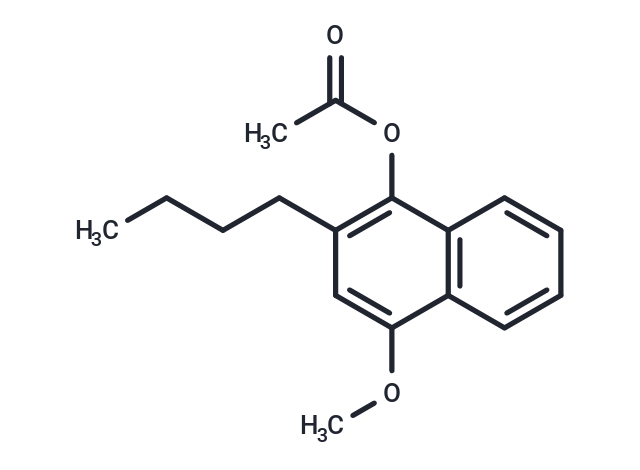Shopping Cart
Remove All Your shopping cart is currently empty
Your shopping cart is currently empty
Bunaprolast (U66858) is a novel and potent leukotriene B4 (LTB4) inhibitor.Bunaprolast exhibits oxidative degradation activity and inhibits lipoxygenase and TXB2 release.

| Pack Size | Price | USA Warehouse | Global Warehouse | Quantity |
|---|---|---|---|---|
| 1 mg | $700 | - | In Stock | |
| 5 mg | $1,800 | - | In Stock |
| Description | Bunaprolast (U66858) is a novel and potent leukotriene B4 (LTB4) inhibitor.Bunaprolast exhibits oxidative degradation activity and inhibits lipoxygenase and TXB2 release. |
| Targets&IC50 | LTB4:250±85 nM |
| In vitro | Bunaprolast (U-66,858) is metabolized through deacetylation to produce an initial metabolite, U-68,244, which retains similar pharmacologic efficacy. This study focuses on their ability to inhibit the ionophore-induced production of leukotriene B4 (LTB4) in human whole blood (WB). Pre-treatment with Bunaprolast or U-68,244 for one minute before exposure to calcium ionophore A23187 yields inhibition concentrations (IC50s) of 1080±644 nM and 820±442 nM respectively, which improve to 250±85 nM and 270±79 nM after 60 minutes. This inhibitory effect is comparable to the lipoxygenase inhibitor AA-861, whereas vitamin K and Bunaprolast's sulfate conjugate only inhibit LTB4 release at higher micromolar levels. Additionally, Bunaprolast significantly reduces thromboxane A2 release (p<0.02) compared to the cyclooxygenase (CO) inhibitor Flurbiprofen, underscoring its potential as a therapeutic agent. |
| In vivo | The IgE-mediated hypersensitivity to Ascaris antigen in reactor rhesus primates is utilized to evaluate the pharmacologic profile of Bunaprolast (U-66,858). Oral administration of Bunaprolast shows dose-related inhibition of resistance (RL) and compliance (Cdyn) changes, while aerosol administration results in dose-independent inhibition. In 15 animals receiving aerosols (52±32 to 53±10% inhibition for RL, p=0.05, and 45±19 to 28±19% inhibition for Cdyn, p=0.05) at concentrations from 5.0% to 0.1%, Bunaprolast demonstrates significant effects. Orally, inhibition is observed 1-4 hours post-administration. In 5 animals, oral doses of 10 and 5 mg/kg result in inhibition (RL by 98±2 to 78±1.5%, p=0.01, and Cdyn by 75±17 to 60.9±9.1%, p=0.05) for 10 and 5 mg/kg of Bunaprolast, respectively[1]. |
| Synonyms | U66858 |
| Molecular Weight | 272.34 |
| Formula | C17H20O3 |
| Cas No. | 99107-52-5 |
| Smiles | O=C(OC=1C=2C=CC=CC2C(OC)=CC1CCCC)C |
| Relative Density. | 1.084g/cm3 |
| Color | Yellow |
| Appearance | Solid |
| Storage | store at low temperature | Powder: -20°C for 3 years | In solvent: -80°C for 1 year | Shipping with blue ice/Shipping at ambient temperature. |
| Size | Quantity | Unit Price | Amount | Operation |
|---|

Copyright © 2015-2025 TargetMol Chemicals Inc. All Rights Reserved.